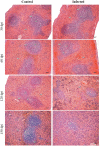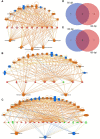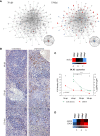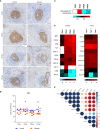Splenic Transcriptional Responses in Severe Visceral Leishmaniasis: Impaired Leukocyte Chemotaxis and Cell Cycle Arrest
- PMID: 34804009
- PMCID: PMC8602831
- DOI: 10.3389/fimmu.2021.716314
Splenic Transcriptional Responses in Severe Visceral Leishmaniasis: Impaired Leukocyte Chemotaxis and Cell Cycle Arrest
Abstract
Structural changes in the spleen have been reported in several infectious diseases. In visceral leishmaniasis (VL), a severe parasitic disease caused by Leishmania spp., the loss of white pulp accompanies a severe clinical presentation. Hamster model reproduces aspects of human VL progression. In the early stages, a transcriptomic signature of leukocyte recruitment was associated with white pulp hyperplasia. Subsequently, impaired leukocyte chemotaxis with loss of T lymphocytes in the periarteriolar lymphoid sheath occurred. This differential gene expression was subsequently corroborated by transcriptomic profiling of spleens in severe human VL. At the latest stage, spleen disorganization was associated with increasing clinical signs of VL. White pulp disruption was accompanied by decreased DLK1 expression. The expression of CXCL13, CCR5, CCL19, CCR6, CCR7 and LTA decreased, likely regulated by CDKN2A overexpression. Our findings enlighten a pathway implying cell cycle arrest and decreased gene expression involved in spleen organization.
Keywords: hamster; spleen disorganization; spleen pathology; transcriptomic (RNA-Seq); visceral leishmanaisis; white pulp remodeling.
Copyright © 2021 de Melo, Guimarães Torres, Hermida, Fontes, Mesquita, Brito, Ramos, Fernandes, Freitas, Khouri, Costa and dos-Santos.
Conflict of interest statement
The authors declare that the research was conducted in the absence of any commercial or financial relationships that could be construed as a potential conflict of interest.
Figures





Similar articles
-
Low CXCL13 expression, splenic lymphoid tissue atrophy and germinal center disruption in severe canine visceral leishmaniasis.PLoS One. 2012;7(1):e29103. doi: 10.1371/journal.pone.0029103. Epub 2012 Jan 5. PLoS One. 2012. PMID: 22242159 Free PMC article.
-
Phenotypical Characterization of Spleen Remodeling in Murine Experimental Visceral Leishmaniasis.Front Immunol. 2020 Apr 15;11:653. doi: 10.3389/fimmu.2020.00653. eCollection 2020. Front Immunol. 2020. PMID: 32351510 Free PMC article.
-
Histological Disorganization of Spleen Compartments and Severe Visceral Leishmaniasis.Front Cell Infect Microbiol. 2018 Nov 13;8:394. doi: 10.3389/fcimb.2018.00394. eCollection 2018. Front Cell Infect Microbiol. 2018. PMID: 30483481 Free PMC article. Review.
-
Pro-Cellular Exhaustion Markers are Associated with Splenic Microarchitecture Disorganization and Parasite Load in Dogs with Visceral Leishmaniasis.Sci Rep. 2019 Sep 10;9(1):12962. doi: 10.1038/s41598-019-49344-1. Sci Rep. 2019. PMID: 31506501 Free PMC article.
-
Mechanisms of resistance and susceptibility to experimental visceral leishmaniosis: BALB/c mouse versus Syrian hamster model.Vet Res. 2011 Feb 23;42(1):39. doi: 10.1186/1297-9716-42-39. Vet Res. 2011. PMID: 21345200 Free PMC article. Review.
Cited by
-
Leishmania infection-derived extracellular vesicles drive transcription of genes involved in M2 polarization.Front Cell Infect Microbiol. 2022 Aug 25;12:934611. doi: 10.3389/fcimb.2022.934611. eCollection 2022. Front Cell Infect Microbiol. 2022. PMID: 36093197 Free PMC article.
-
An integrated analysis of the structural changes and gene expression of spleen in human visceral leishmaniasis with and without HIV coinfection.PLoS Negl Trop Dis. 2024 Jun 6;18(6):e0011877. doi: 10.1371/journal.pntd.0011877. eCollection 2024 Jun. PLoS Negl Trop Dis. 2024. PMID: 38843306 Free PMC article.
References
-
- Moreira N das D, Vitoriano-Souza J, Roatt BM, Vieira PM de A, Ker HG, Cardoso JM de O, et al. . Parasite Burden in Hamsters Infected With Two Different Strains of Leishmania (Leishmania) Infantum: “Leishman Donovan Units” Versus Real-Time PCR. PloS One (2012) 7:e47907. doi: 10.1371/journal.pone.0047907 - DOI - PMC - PubMed
Publication types
MeSH terms
Substances
LinkOut - more resources
Full Text Sources
Miscellaneous

